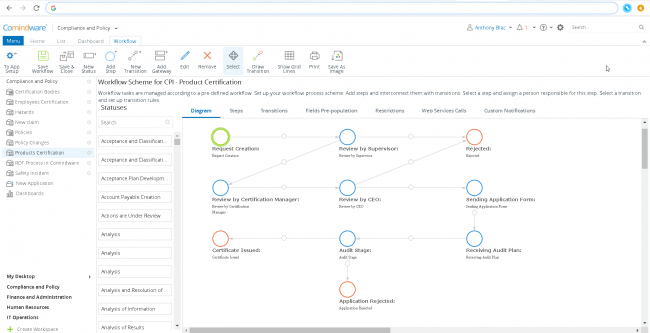As organizations pursue increased effectiveness with business process management (BPM) and automation, they come across many powerful tools and ideas. Business Rules Engine (BRE) and Workflow Engine (WFE). are two terms which tend to pop up and are at times erroneously used akin. Both are critical in automating business rules and processes, but knowing the differences between BRE and WFE is paramount in deciding what automation system to choose and what software solutions to design for your business processes in the year 2025. This guide clarifies the rules engine vs workflow engine distinction.
What is a Business Rules Engine (BRE)? The Decision Logic Powerhouse
Core Definition and Purpose: A Business Rules Engine is a software component specifically designed to externalize, manage, and execute business rules – the specific logic, policies, constraints, and conditional statements that govern business decisions. Its primary purpose is to separate the “decision logic” (the what and when of decisions) from the core application or process code (the how tasks are performed). This allows organizations to automate decision making processes based on predefined criteria.
How it Works: A BRE typically takes input data, evaluates it against a set of defined business rules (often stored in a rule repository), and produces an outcome or decision. These rules are often expressed in formats easier to understand than traditional programming language code, such as:
- IF-THEN statements:(e.g., IF customer_credit_score < 600 THEN decline_loan_application).
- Decision Tables:Structured tables mapping conditions to actions or outcomes, excellent for complex logic.
- Decision Trees:Graphical representations of decision paths.
- Other declarative rule formats. A key principle is that business analystsor subject matter experts can often modify rules through a user friendly interface without needing deep coding skills or redeploying the entire application. The engine handles the rule execution.
Key Benefits:
- Agility: Permits swift modifications of business logic ( pricing, eligibility, compliance) without changing the application code.
- Consistency: Aids in the maintaining consistent application of policies and rules across all different transactions and interactions.
- Centralization: Gives a holder a chair for a particular location about managing the business rules as to where they will be maintained, audited and comprehend easily.
- Transparency: Assures that the decision logic is visible and understandable by business stake holders.
- Compliance regulation: Definitively stresses the authority regulations damped on the businesses activities and the inside active methods and systems put within the business, enforcing rules definable policies in other that it is clear and unambiguous.
Common Use Cases:
- Insurance Underwriting: Determining policy eligibility and premiums based on applicant data.
- Loan Origination: Assessing creditworthiness and approving/denying loan applications.
- E-commerce: Calculating dynamic pricing, discounts, or shipping options based on user profiles, location, or cart contents.
- Fraud Detection: Identifying potentially fraudulent transactions based on predefined patterns.
- Compliance Checks: Ensuring processes adhere to regulatory mandates (e.g., healthcare, finance).
- Personalization: Tailoring content or offers based on user attributes.
What is a Workflow Engine (WFE)? The Process Orchestration Master
Core Definition and Purpose: A Workflow Engine (often synonymous with a Business Process Engine or what is process engine referring to this component) is a software component that manages and executes the sequence of steps or tasks within a defined business process (a “workflow”). Its core function is to orchestrate the flow of work, data, and tasks between different human participants and/or automated systems according to predefined process models. If you ask what is a workflow engine, think process automation and coordination. Understanding what is the difference between workflow and workflow engine is key: workflow is the process design, the engine is the software that runs it.
How it Works: A WFE interprets a formal process definition (often created using standards like BPMN – Business Process Model and Notation) which outlines:
- The sequence of activities/tasks.
- The conditions that determine the path through the workflow (workflow business rules, but simpler logic than a full BRE handles).
- The roles or systems responsible for each task.
- The data required and generated at each step. The engine manages the state of each running process instance, routes tasks to the appropriate people or systems, handles escalations or timers, and tracks progress. It ensures tasks happen in the correct order, involving the right participants.
Key Benefits:
- Efficiency:Automates task routing, notifications, and handoffs, significantly reducing reduced manual effort and delays.
- Visibility:Provides real-time tracking of process status, identifying bottlenecks and performance issues.
- Standardization:Enforces consistent execution of business processes according to defined models.
- Error Reduction:Minimizes human error inherent in manual task management and handoffs.
- Accountability:Clearly defines task ownership and tracks completion times.
- Collaboration:Facilitates smoother collaboration between different teams or individuals involved in a process.
Common Use Cases:
- Order Fulfillment: Managing steps from order placement to shipping and invoicing.
- Onboarding: Orchestrating tasks across HR, IT, and Facilities.
- Document Approval Processes: Routing documents for review and sign-off.
- Customer Support Ticket Resolution: Managing the lifecycle of a support request.
- Loan Application Processing: Moving an application through various stages of review and approval.
- Content Publishing Workflows: Managing steps from creation to review and publication.
Rules Engine vs. Workflow Engine: The Key Differences Summarized
While both contribute to automation and involve “rules,” their focus and function are distinct. Here’s a business rules engine comparison with a workflow engine:
|
Feature |
Business Rules Engine (BRE) |
Workflow Engine (WFE) |
|
Primary Goal |
Automate Decision Making Processes / Logic |
Orchestrate & Automate Process Steps/Tasks |
|
Core Focus |
What decision to make based on conditions |
How a process flows (sequence of tasks) |
|
Handles |
Complex conditional logic, policies, constraints |
Sequence, task assignment, state management |
|
Input |
Data / Facts / Conditions |
Task completion status, events, data |
|
Output |
Decision / Outcome / Action trigger |
Next task assignment / Process status update |
|
State Mgt. |
Typically stateless (evaluates current data) |
Stateful (tracks progress of each process run) |
|
Complexity |
Manages complexity in decision logic |
Manages complexity in process flow & coordination |
|
Primary User |
Business Analysts, Policy Managers |
Process Designers, Operations Managers |
|
Analogy |
The “Brain” (making decisions) |
The “Conductor” (orchestrating the performers) |
Essentially, a BRE answers “Given these conditions, what should happen?” while a WFE answers “Given the process design, what is the next step?” This highlights what is the difference between workflow and workflow engine functionality versus rule engine functionality.
Powerful Tools Working Together: BRE and WFE Synergy
The real power often comes when BRE and WFE work in tandem within a business process management strategy. They are not mutually exclusive; they are complementary powerful tools.
- Scenario: Consider an insurance claim processing workflow managed by a WFE.
- WFE: Receives a new claim (initiates workflow).
- WFE: Routes the claim data to the BRE for validation.
- BRE: Executes rules to check policy validity, coverage limits, and potential fraud flags based on the claim data (business rules automation).
- BRE: Returns a decision (e.g., “Valid, proceed,” “Flag for review,” “Deny”).
- WFE: Based on the BRE’s decision, routes the claim to the next appropriate step in the workflow (e.g., to an adjuster, a fraud investigator, or triggers a denial notification).
In this workflow and rules engine combination, the WFE orchestrates the overall process flow, while the BRE provides the intelligent decision-making capability at specific points within that flow. This creates sophisticated, automated, and rules-based workflow solutions. A BPM rules engine often refers to a BRE integrated within a broader BPM suite that includes a WFE.
Do I Need a Workflow Engine, a Rules Engine, or Both in 2025?
The answer depends on your specific business requirements:
- Choose a WFE if: Your primary challenge is managing the sequence and coordination of tasks involving multiple steps, people, or systems. You need to improve process efficiency, visibility, and standardization (e.g., complex approval chains, onboarding processes).
- Choose a BRE if: Your main challenge involves complex, frequently changing decision logic that needs to be applied consistently and managed separately from application code. You need agility in updating policies or calculations (e.g., dynamic pricing, eligibility rules, compliance checks). A dedicated business rules engine software or rules engine software makes sense here. Conducting a rules engine comparison or business rule engine comparison is important.
- Choose Both if: Your process involves both complex sequencing/coordination and complex decision points within that sequence. This is common in many core business operations like loan processing, insurance underwriting, or sophisticated order management where business rule based process automation is desired. A business process workflow engine often implies this combined capability or tight integration.
Many modern business process engines or BPM suites incorporate both workflow orchestration and business rule configuration workflow capabilities, blurring the lines but maintaining the distinct conceptual functions. The rise of low-code/no-code platforms also allows business analysts to configure both workflow steps and decision rules via a user friendly interface, further integrating these concepts.
Conclusion: Harnessing the Right Engine for Intelligent Automation
Understanding the rules engine vs workflow engine difference is fundamental for effective business process automation in 2025. A Business Rules Engine (BRE) excels at externalizing and executing complex decision logic, promoting consistency and agility to inform decisions. A Workflow Engine (WFE) masterfully orchestrates the sequence of tasks in a process, driving efficiency and visibility.
While distinct, these engines are often most powerful when used together – the WFE managing the flow, calling upon the BRE for critical decision points within complex workflows. Choosing the right automation tool, whether a standalone engine, a combined rule based workflow engine, or a comprehensive BPM suite, depends on analyzing your specific business requirements. By leveraging these technologies appropriately, organizations can achieve significant reductions in manual effort, ensure consistent execution, and build smarter, more agile executable business processes to thrive in the modern landscape.

